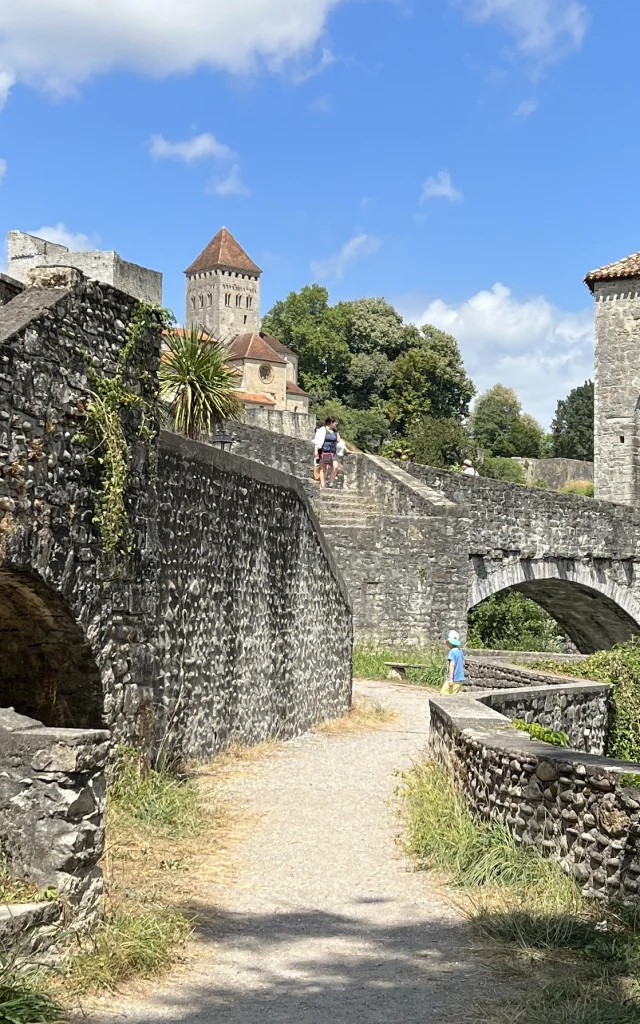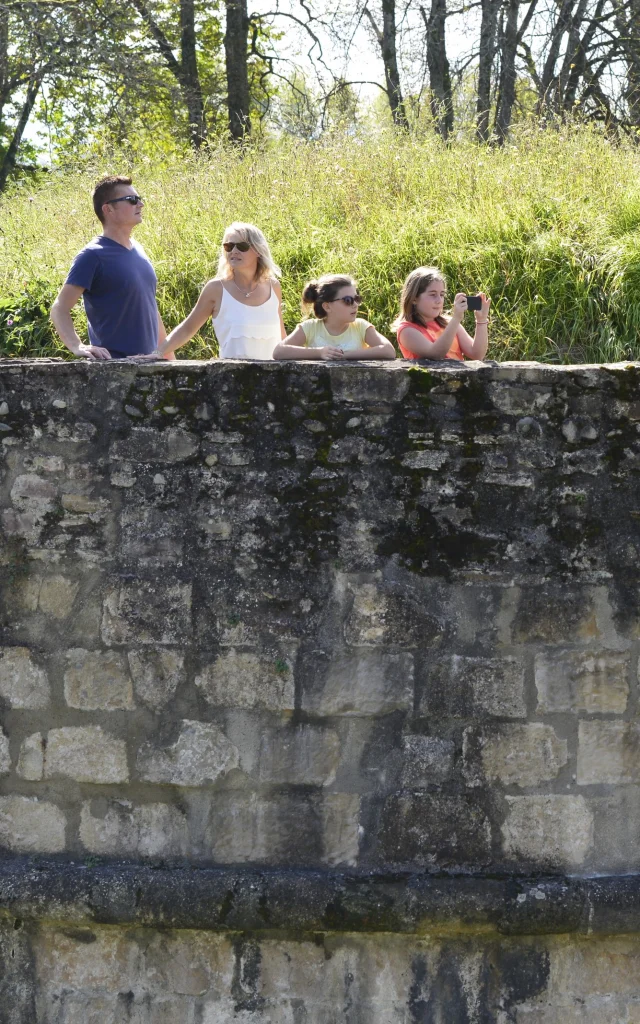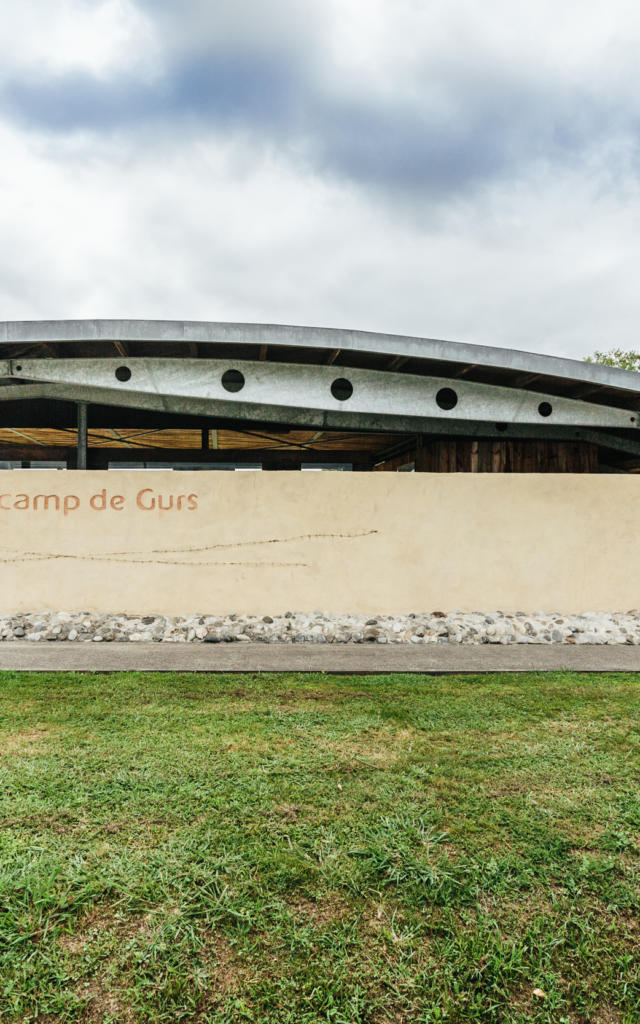 Visite de Salies-de-Béarn
Visite de Salies-de-Béarn0. Salies-de-Béarn tourist office
Read the description
Welcome to my realm. I am Jeanne d’Albret, Viscountess of Béarn since 1555. As I visit Salies today, 11th February 1568, I shall share with you its rich and fascinating history.
It all began very long ago. Attracted by the surrounding saltwater springs, men came to settle at the foot of the hills and built the first houses, the ostau. In the Middle Ages, the little cité du sel became the 5th largest town in the Béarn.
These Salisians, known as Beziis or neighbours, had a special privilege: the right to draw salt water from the Bayaà fountain to make salt for curing. Passed down by the head of the family, this ancestral privilege continues to this day, represented with dignity by the Corporation des Part-Prenants.
Are you ready to explore almost 600 years of history?
En aban ! Onwards, then! Let us begin with the boar fountain, behind you on the square under the arcades of the imposing building with shops.
Listen to the description
 Office de tourisme à Salies-de-Béarn
Office de tourisme à Salies-de-Béarn1. The boar fountain
Read the description
There’s also a legend: while hunting on his land, Viscount Gaston Febus and his courtiers wounded a wild boar. The boar came to die near the salt water of the Bayaà. Covered in salt crystals, the animal breathed its last words: si you nou eri mourt, arès n’y biberé. If I hadn’t died here, no one would live here. The first oustaus were built following this discovery.
By the way, have you noticed how shiny the boar’s head is? It is said to have many qualities… go ahead, rub it and make a wish! Now, I was talking about the saltwater spring… have you found it yet?
Turn round and take a look at the square. Picture a 13-metre diameter pool, with wide steps on all 7 sides, into which flows the ayga salada, the salt water source with 300g of salt per litre of water. That’s 10 times saltier than sea water!
Let’s carry on under the arches of the town hall.
Listen to the description
2. Distributing the ‘sauce’ or salt accounts
Read the description
In the past, market halls were located within the town hall. Every day, butchers would sell their meats and other speciality products. Nowadays, the market takes place every Thursday morning under these arches and in the town squares, where you’ll find delicious produce from my lands.
Next to the entrance to the town hall is a video screen where you can watch a short film explaining all the mysteries of drawing salt water.
Turn into the small Rue de la Mairie, on the corner of the Maison des Part-Prenants. Don’t miss the Béarn coat of arms, with its two red cows on a yellow background, proudly displayed on the balcony.
You’ll also notice another emblem: two young men carrying a wooden pitcher. Symbolic figures in the history of Salies, these men or tiradous carried the salt water, or sauce, in 92-litre buckets, known as sameaux. This distribution of sauce accounts is celebrated every year during the Fête du Sel in September.
But let’s continue our journey. After passing the small covered passage, turn right into the Chemin de Larroumette, a little further on your left.
Just a few more steps before you discover the Château Saint-Pé. En aban ! On we go!
Listen to the description
3. Château Saint-Pé
Read the description
So here we are, just a hundred metres from the Place du Bayaà, and in front of you stands a huge medieval residence: the Château Saint-Pé. Once a noble house or domenjadure, it has recently been restored to reveal all the nobility of this Historic Monument. Also used to defend the town in the Middle Ages, this chateau stood on the ramparts at the foot of the hill known as the Pain du Sucre, or Sugar Loaf.
But now I recall this house has a rather sad history. My very dear son, Henri IV, King of France, converted to Catholicism after the massacre on Saint Bartholomew’s Day. On my lands in the Viscounty of Béarn, Henri ordered Pierre de Lancre to purge the country of all witches and sorcerers. Pierre de Lancre lived here in 1609 and had women locked up for being locked up as Broutches, or witches.
You mightn’t think it, but I promise you beliefs are still very strong here in the Béarn…
Let’s retrace our steps: to the right, take the small alleyway or carrerote, with a large edifice at one end. Don’t miss the 17th-century houses on your left, before continuing on your way.
Listen to the description
4. The Bergeras house
Read the description
You have just passed through the narrow alleyway known as the galley. These cramped alleys were where the tiradous, the famous salt-water carriers could get to some frightful debauchery. Their runs could be slowed down as their buckets jammed between the walls of the alleyway.
You are now standing in front of the Bergeras house. If you look closely, you will see a carving on the wall of the house. It reads as follows: Michel Bergeras, Charpantier in 1640. Sieur Bergeras was a fine carpenter and from generation to generation, he developed the famous École de Salies, a style of wood craftsmanship and joinery which is still recognised today. But I must tell you about the Cagots…
Michel Bergeras was a Cagot, a Crestiaa. For as long as I can remember, Cagots were considered outcasts in my Viscounty. Isolated from the rest of the community, they were forbidden to work the land. Condemned to working with wood, they were excellent carpenters on grand projects such as the Château de Pau and the church at Monein. In Béarn, you will still find vestiges of these beliefs, such as the small side doors in the churches of Salies, Sauveterre, Escos and Navarrenx.
Let’s continue our walk and come out of the Impasse Argenton. As you reach Rue Elisée Coustère, turn right and head towards the Pont de la Lune. To your left, notice the graceful Belle Epoque balconies added to the facades of the 18th century houses.
Listen to the description
5. Pont de La Lune
Read the description
Let’s pause at the Pont de la Lune – Moon Bridge. On your right, two-storey houses stand proudly beside the river Saleys. Occasionally, you’ll be surprised to see piles sticking out of the water below Place Jeanne d’Albret. These are the remains of an old access to the river, used for washing clothes and washing up household utensils. The dyers in the neighbouring streets also used to dump their waste there.
On your left, you can see the old dyke that fed the Trotte-chien mill, destroyed in 1893 to make way for a hydro-electric plant. It stands opposite you, still spruce in white limestone and red brick. This power station produced all the electricity needed to light up the old town and, above all, the grand homes and hotels of the new thermal quartier – the so-called “foreign colony”!
Notice the half-timbered houses on stone piles that resist the flooding of the Saleys river every year. Can you see the Maison Marrou, a symbol of Salies, both yesterday and today? This fine medieval house is currently being restored. See the bread oven, perched above the river?
Beyond the Pont de la Lune is the Place Jeanne d’Albret. My Square!
In the old days, it was the Clauson, a square lined with tall houses, some of which were homes while others were hotels, bars, cafés and shops in the 19th century. These buildings all had overhanging storeys supported by arcades. These houses with their awnings protected shops below in the Middle Ages. This square was the first and most important in the history of Salies.
It remained important until the end of the 19th century, when stagecoaches and horse-drawn carriages would stop here, bringing travellers and foreigners who had come to bathe in the future thermal spa, until the train station was built in 1884.
But now it’s time to head off towards the spa quarter, which developed outside the old town towards your left.
Listen to the description
6. The church of Saint Vincent
Read the description
As you walk up this long street, formerly the Route de Bayonne, you will see the fortified church of Saint Vincent on your right.
Salies has two churches: Saint-Martin on the heights of the town, and Saint-Vincent, which you see opposite. Both were dedicated to patron saints associated with the vine and winegrowers, and both had their own particular destinies. The church of Saint-Vincent, dating from the end of the 15th century, actually adjoined the town’s old ramparts, and you can still see arrowslits and other defensive systems here and there.
Let’s continue our stroll in the direction of the public gardens, where the old shops on your right face an imposing building that has now been divided into flats: the Hôtel de la Paix.
Listen to the description
7. Thermal spa quarter
Read the description
A Diu Biban – Praise be! We’re coming to the chic new area of Salies, which aristocrats and genteel people from all over France and Europe will come to settle.
But before we continue our tour, there’s something I must tell you! At that time, Salies was reputed to be a dirty town, with animals in the streets and manure littering the ground and squares. When wealthy outsiders began to arrive in Salies, the national press and spa guides revealed how unwholesome this small Béarn town was. It was clear that the town urgently needed to fix its reputation and clean itself up with a programme of improvements. They included covering the saltwater pool in the town centre, installing mains drainage and creating wide, open streets. The new spa quarter was built outside the old town, in keeping with the new Haussmannian architectural style.
Come into the middle of the public garden towards the bandstand. This is one of the landmarks of the foreign colony. Built in 1887, the bandstand offered afternoon concerts for bathers and was a popular meeting place for “curistes”.
Opposite you, before the construction of the thermal baths which visitors still enjoy today, was the first industrial salt works.
Since 1804, French salt laws have required all salt production sites to manufacture 500 tons of salt per year. To continue producing this salt, the Salies Parts-Prenants built the town’s first industrial site at their own expense. Enclosed by a 3-meter-high wooden fence and under surveillance night and day, the saltworks could produce all Salies’ salt in a single location.
In 1888, a fire completely destroyed the factory, which was rebuilt near the train station a short distance away. In its place, on the site of the fire, the thermal spa was built. That is the building you see today, dating from 1888. Echoing the oriental-style architecture that was very fashionable at the time, you’ll see the Chalet on your right, a popular spot for local and foreign gentlemen to discuss politics and business over a glass of absinthe or while smoking a cigar.
All around you are the ghosts of old hotels: the Hôtel de la Paix on your left, where Marcel Proust and his mother stayed for several years, and on your right, the Hôtel du Parc, which you can still reach by crossing Boulevard Saint-Guily. It was in this hotel that great personalities and members of the international aristocracy stayed throughout the year. Claude Monet came to exhibit his paintings in May 1886. Do have a look inside this immense building, where you’ll find all the luxury of a Belle Epoque hotel.
As you approach the wild boar roundabout where the Bayonne and Puyoô roads meet, you’ll see the old railway line, though its bridges have all gone now. Hidden in the heights to your right, the ruins of the Hôtel de France et d’Angleterre eagerly wait to be restored.
Our walk is coming to an end, and I hope it has pleased you. Together, we have walked through almost 600 years of history…
I invite you to make the most of Salies by visiting the Salines saltworks and the Museum of Salt. Do sample some of our fine charcuterie and tasty dishes, and why not relax or pep up your energy with a saltwater bath at the thermal spa…
And as we say in these parts, Adishatz !









